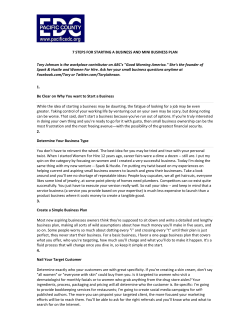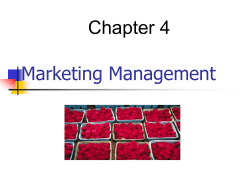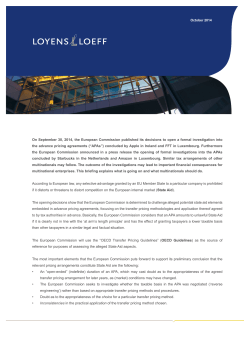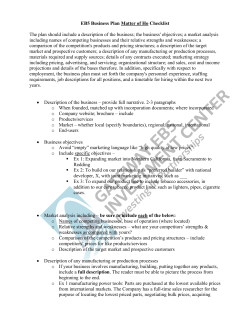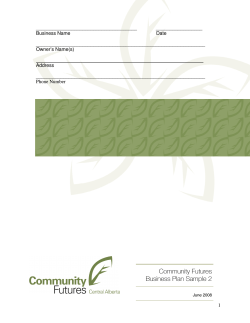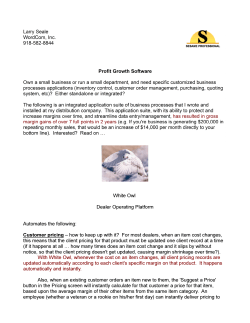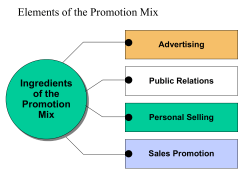
How to Write a Business Plan Small Business Development Center
Small Business Development Center (SBDC) How to Write a Business Plan A well-written comprehensive business plan forms the basis for the success of any business venture. The business plan is a written document that clearly defines the concept and goals of the business and outlines the methods of achieving them. It is a written model of the entrepreneur’s vision It provides an opportunity to critically evaluate your business idea and to improve control and competitive advantage through knowledge, focus and diligent implementation. The following pages describe the key elements of a business plan. The comments and questions included for each section are intended as guides. If you have more questions, be sure to ask and answer them. Remember, your success depends on the completeness of your planning process. Remember: Business is like an automobile, it won’t run itself except downhill! 1 Elements of a Business Plan A. Cover Sheet B. Table of Contents C. Body a. Executive Summary b. Management & Organization Plan c. Product & Service Plan d. Marketing & Sales Plan e. Operations Plan f. Financial & Growth Plan g. Succession Plan D. Financials Section a. Pro Forma Statements b. Income Statements c. Balance Sheet d. Cash Flow e. Source & Use of Funds Statement f. Break Even Analysis g. Other Financial Analysis h. Personal Net Worth Statement (financing proposals) i. Historical Financial Information (existing businesses) j. Capital Equipment List E. Supporting Documents Section (Appendix) a. Letters of Intent b. Key Contracts c. Resumes of Key Managers d. Endorsements e. Technical Information f. Manufacturing Information g. Marketing Material h. Floor Plan i. Other Relevant Information or Analysis 2 Cover Sheet Business Name Business Address Business Telephone Number Owner’s Name(s) If the plan is being used as a financing proposal, the cover sheet should include a Statement of Purpose which describes the amount of financing sought, what the financing will be used for, the equity contribution of the owner(s) and the sources of repayment. Note: The main difference between a business plan and a financing proposal is one of emphasis rather than design. The main function of the plan is to enable you to understand and master the complexities of your business while the function of the financing proposal is to show your prospective backers that you not only know what you are doing but will also make their investment as risk-free as possible. Table of Contents The Table of Contents should list the title of each section of the document and indicate the page number where each is located. It should also list the specific support items (appendices) by name. This page will be done last, since it requires the entire document as input. It allows the reader to locate specific sections quickly. Executive Summary This is a clear, concise, and compelling summary of your business plan. In effect, it is the concept paper for the business. Combined with the financials, the executive summary is often enough to convince potential investors that your business concept is worthy of consideration. 3 The executive summary is written after all the other elements of the business plan have been thoroughly evaluated. It can be in one of two forms: synopsis or narrative. The synopsis style summary presents the major information and conclusions found in each business plan section. It treats each section relatively equally and briefly. It often concludes with funding requests and identification of key outside resources including your accountant, bank and lawyer. The narrative style summary presents the business concept in a story like fashion. It contains fewer sections than the synopsis style and focuses on the distinctive or impressive aspects of the company. Narrative style summaries can generate enthusiasm for businesses that are breaking new ground, have a particularly vital element (i.e. patent, well-known participant) or impressive history. Executive Summary Characteristics 1) Length is from one to three pages 2) Language is clear, believable, professional and authoritative 3) The are presented quickly to inform the reader of the following: 4) What the business is 5) What products and services will be offered 6) What the target markets- are, size, anticipated market share 7) Why you can serve the target markets better than competition 8) Why you have chosen your location 9) What management and personnel are required to operate 10) Why (if appropriate) someone else’s investment will make your business more profitable 4 Business Description The business description provides the basic details about your business and the product or service you will be offering. This section should be straightforward and relatively easy to prepare. The one component which will take significant thought beforehand will be your Mission Statement. The Mission Statement will come at either the beginning or the end of this section and will set the tone for the entire document. Elements of the Business Description A. Mission Statement a. The mission statement is you company’s guiding principle. It sums up the basic objectives of your company in one or two sentences b. Every word of the mission statement should be important c. It should reflect your company’s philosophy in terms of products or services, quality, price, service, management style and relationship to customers and employees. Examples: Walt Disney – To make people happy Microsoft Corporation - To enable people and businesses throughout the world to realize their full potential Nike - To bring inspiration and innovation to every athlete in the world IBM - We want to be the best service organization in the world. 5 B. Name and Legal Form of Business a. Include legal name, brand or trade name, DBA’s or subsidiary names b. If new business, select a name that won’t limit ability to grow and change c. Is this a sole proprietorship, partnership, corporation, etc. d. If a partnership, what percentage is owned by each partner e. If a corporation, where is it incorporated, how many shares outstanding and who are major shareholders? C. Management a. Identify the key managers in the company and their functional roles b. If you have a Board of Directors, Advisory Board or other governing body, describe and mention membership if it is impressive D. Location a. Describe the business location and the geographical area your company serves E. Development and Financial Stage a. Are you a start-up or have you made progress in building the company b. What is your phase of development? How far along have your plans progressed? c. How have you been funded to date? d. What is level of personnel at present? e. Are you seeking additional capital? If so, how much and why? f. Products and Services g. This can be included in the Business Description or listed separately. It is advisable to list separately if you product or service is technical or complex. If separate, the product and services section will follow the business description. In describing products and services include: 6 h. The nature and application of product or service, what do you sell? i. Patents, trademarks, copyrights, or other proprietary features – duration and impact on competitive advantage j. Benefit of your product or service to the customer k. Seasonality or cyclicality of your product l. Hours and days of operation m. Distinctive or unique attributes that separate it from the competition Strategic Plan A. Create a “vision” using the S.W.O.T. Analysis a. Identify the company’s strengths, weaknesses, opportunities, and threats in light of its current operating and economic development b. Drawing on S.W.O.T. analysis, determine how you envision your company c. Quality leader: Highest quality product, reputation for excellence? d. Niche leader: Carve out a market segment and dominate it? e. Market or industry leader: Large, well-known company dominating market in terms of sales or products? f. Innovator: New or different products and services, or change the way the market views the product or service? g. Exploiter: Copy current success or trends? h. Steady Provider: Maintain a stable business profit and income? B. Use your vision to develop an overall strategy a. Market Penetration: Introduce products and market to gain foothold 7 b. Promotion and support: intensify marketing support to increase sales and gain market share, increase current product or service line development c. Expansion: increase sales by adding products or services, production capacity, distribution channels, etc. d. Increase Focus: eliminate some products or services, focus resources on increasing profit margin of remaining line e. Diversify: add new product or service lines, buy companies, expand sales f. Refocus: Modify nature of company due to changing conditions, reserves C. Identify Key Results Areas a. Identify areas where the company must achieve success to grow and prosper 1. Rate each area’s needed expenditure of funds 2. Describe the specific priorities or amounts in each area D. Establish specific objectives for each Key Results area a. If a key results area is to “increase revenues”, your strategic statement might be to “Increase revenues from new customers (market penetration), opening new branches (expansion), or marketing new products or services (diversify) b. Set specific revenue objectives (i.e. achieve $400,000 by 12/07) c. State all specific objectives in concrete terms; omit goals that are expressed vaguely “developing a substantial increase in revenue. E. Develop tactics or short-term objectives to support the strategic objectives a. To increase revenues tactics might include: change advertising theme, produce and market a new product, change salary structure to base plus commission rather than fixed. b. assign responsibility and timelines for tactic implementation 8 F. Risk Evaluation a. Assess the risks facing your company in each area and describe the steps you can or have taken to reduce the impact of risk factors b. Include risks such as changing demographic, sociological, or technological trends, gaps in management, or impact of new regulations G. Exit Plan How do you plan to reap the rewards when your company is successful? Exit strategies include: a. b. c. d. e. f. g. h. sale to other individuals merger with existing companies go public through the sale of stock acquisition by another existing company buy-out of one or more stockholders by another franchise the concept to others hand down the company to the next generation close the business Marketing Plan The marketing plan lays out the steps your company must take to create customers. It should identify your target market, explain the methodologies you will use to attract and keep customers, outline your pricing strategy, and contain sample advertising and promotional material that you will use. If you can clearly and succinctly state what you sell, to whom, and why they buy from you, you are well on your way to creating an effective marketing plan. The marketing plan will contain two parts: the market analysis and marketing strategies. 9 A. Market Analysis a. Target Market Analysis 1. 2. 3. 4. 5. 6. Age Sex Profession Income Level Educational Level Residence B. Competitor Analysis a. What is the demand for your product b. Who are the nearest direct and indirect competitors c. Assess the competitors and how their businesses are doing d. Describe unique features of your product or service and why it is distinctive from competitors e. What substitutes for your products exist and how they may impact sales f. What market share do you anticipate C. Location Analysis a. b. c. d. e. f. g. Describe the location What are the strategic advantages of location? Is there opportunity for expansion? What are the neighboring businesses? Are there needed renovations, if so, what is the cost? What is the zoning classification? Is the neighborhood stable, changing, improving, deteriorating? How? h. How is customer access, parking, etc.? C. Marketing Strategies a. Promotional Strategies 1. What is your company’s message? How is it communicated? 2. Is your message consistent in promotional material, company décor and dress, consistent quality? 10 3. What key words are in your marketing materials (i.e. slogan, logo, and packaging)? b. How do you reach potential customers? 1. Advertise? Which media? Direct mail? Which lists? 2. Customer based marketing? Point of purchase promotion? 3. Trade Shows? When and where? 4. Strategic partnering? Cooperative advertising? Licensing, distribution agreements, bundling? 5. Special offers and promotions? Loss leaders? 6. How will you evaluate the effectiveness of each advertising/promotional effort? C. Sales strategies a. How will you actually get customer orders? b. Sales force – who comes into direct contact with your customers? 2. What are their responsibilities? 3. How do you compensate, train, and encourage them? 4. Are they employees or independent contractors? c. What is your sales process? 1. How do you identify and contact potential customers? 2. Who works with current customers? 3. How do you measure sales productivity? Volume or revenue in a given time frame? Percentage of potential customers that become actual customers? d. Who is responsible for product quality and delivery? e. Pricing Strategies 1. Pricing reflects service components, materials, labor and overhead costs. What 11 image will be projected by the pricing? Will customers pay your price? What Price will you set for your product and how does it compare with the competition? 2. Competitive pricing – be sure you’re competing with similar stores 3. Pricing below the competition – difficult to maintain, requires lower costs, can lead to price wars 4. Pricing above the competition – non-price considerations must justify such as service considerations, convenience, exclusivity 5. Retail cost and pricing 6. Follows manufacturers suggested retail prices but doesn’t consider image or competition 7. Price lining – segments market by carrying products in specific price range 8. Multiple pricing – selling multiple units for one price, desirable for low cost consumable products or sales and clearances f. Product Line Strategy 1. When and how will you integrate new or updated products to your existing product line? 2. How will marketing research be conducted to evaluate pricing and determine trends and environmental influences that impact product lines? 3. Are there complimentary products that would enhance your product line? 4. How will you deal with obsolete products? g. Customer Service Strategy 1. Are your products offered “as is” or with warranties? 2. Do you provide unconditional refunds? Manufacturer’s warranty? 3. Are there bonuses for repeat business? 12 4. Is credit given for future business or referrals? Management and Organization The management and organization section is extremely important because it highlights the strengths of the people involved in the organization. Investors know that the experience, skills and personalities of the management team will determine the success of the business. This section should be succinct and objective. It should focus on the relevant backgrounds of the management team and the organizational chart. A. Management Team a. Who are the team members? Principals and key employees, board of directors, advisory committee, consultants and other specialists b. What are the important attributes of the management team? c. Job experience directly related to the current position d. education if it is directly related to this position e. accomplishments that illustrate ability to perform in this capacity f. strengths in the business setting, ability to lead and manage, industry knowledge, financial capabilities g. Are there key personnel to be added? When and what are their qualifications? h. How is management compensated? Are there incentives (i.e. salary, bonuses, profit sharing, equity, stock options)? i. Management structure and style j. Does your business have a hierarchical chart or flat structure? k. Who makes the final decisions? What are the designated areas of responsibility? l. What are the formal lines of authority? 13 m. What voice do employees have when company policies and goals are set? n. How do you develop a sense of teamwork among employees? o. How do you communicate with employees? Meetings, newsletters, informal talks? C. Organizational chart and responsibilities a. Organizational charts are flow charts showing functional areas of responsibility and reporting relationships. The will reflect the management structure. Include these charts in the appendix. C. Employee relations a. b. c. d. e. f. What are your personnel needs now? Future? What skills will be required? How will you go about hiring and training? How will you evaluate performance? What salary and benefits will be provided? What are your company policies on items such as promotion, termination, etc.? g. How are our policies communicated to your employees? Financial Plan This section describes how your business will be financed and how it will maintain a sound financial condition. I t will define the sources of equity and any dividend requirements as well as the sources of debt and their repayment terms. Elements of the Financial Plan A. Industry financial characteristics a. What type of return on capital is typical for this industry? b. What do margins run? c. Are investments in working capital, fixed assets, or inventory high or low? 14 B. Industry Comparison a. How do your business’s financial projections compare to the industry’s financial performance and standards? b. Are your assumptions for growth, revenues and expenses consistent with the experience of others in the field? If not, why? C. Funding requirements a. Much money is needed for start-up or expansion? b. What will be the source of this capital? Debt? Equity? c. How will it be spent? d. What business or personal assets will be pledged as collateral? e. What terms of repayment are feasible? f. What back-up plan will be used if repayment cannot be accomplished as planned? g. How will borrowed funds make your business more profitable? D. Reference to Financial Section a. List or refer to supporting financial statements and analysis b. Explain criteria employed in providing the statements such as valuation and depreciation methods and amortization rates c. Summarize key assumptions and conclusions The Financials 1. Income Projection Statement a. Instructions for income projection statement 2. Balance Sheet a. Instructions for balance sheet 3. Monthly Cash Flow Projection a. Instructions for monthly cash flow projection 4. Assumptions for Pro-forma Financial Statements 5. Sources and Uses of Funds 6. Capital Equipment List 15
© Copyright 2025



